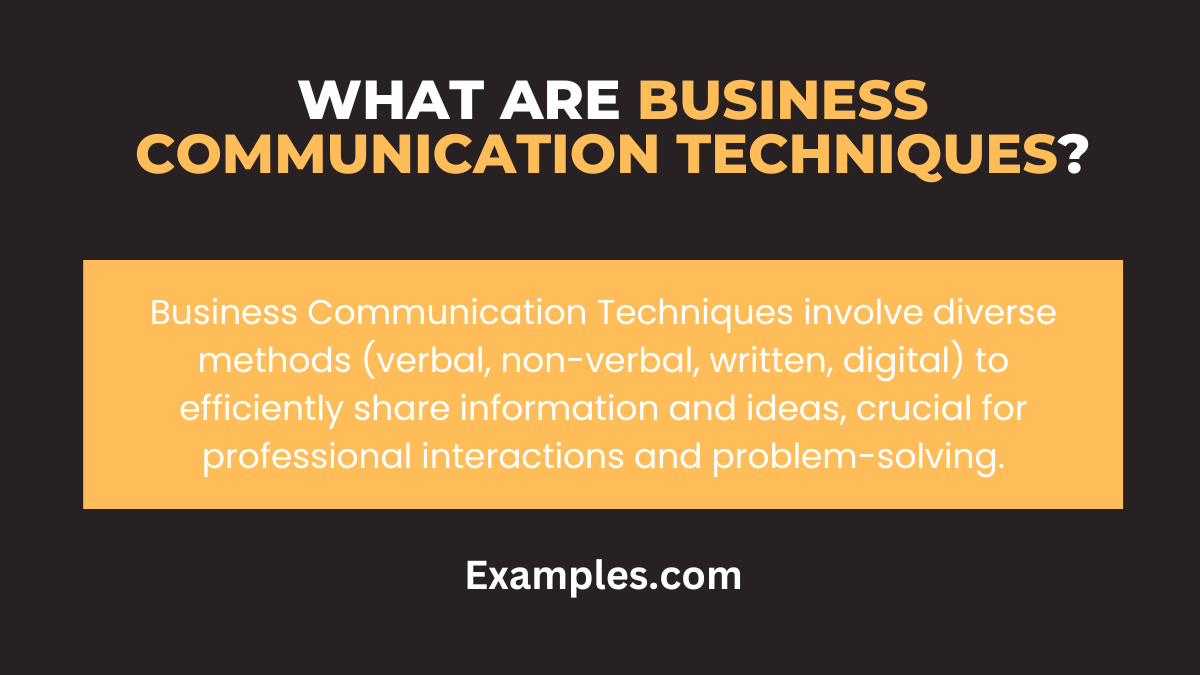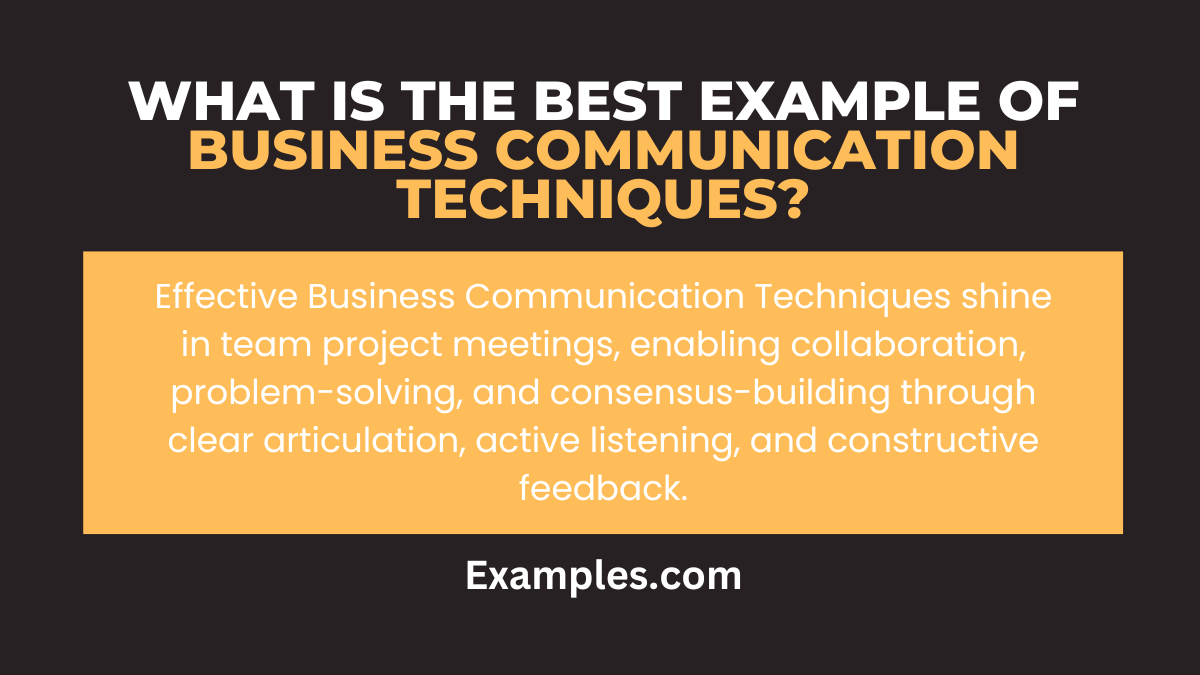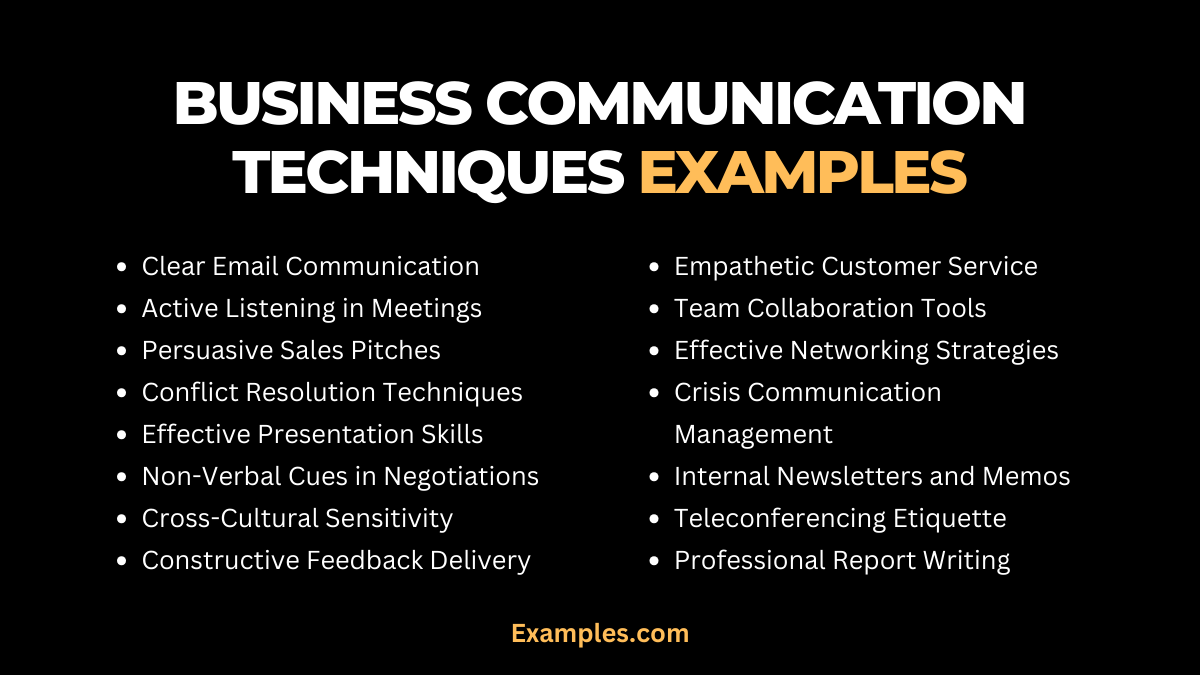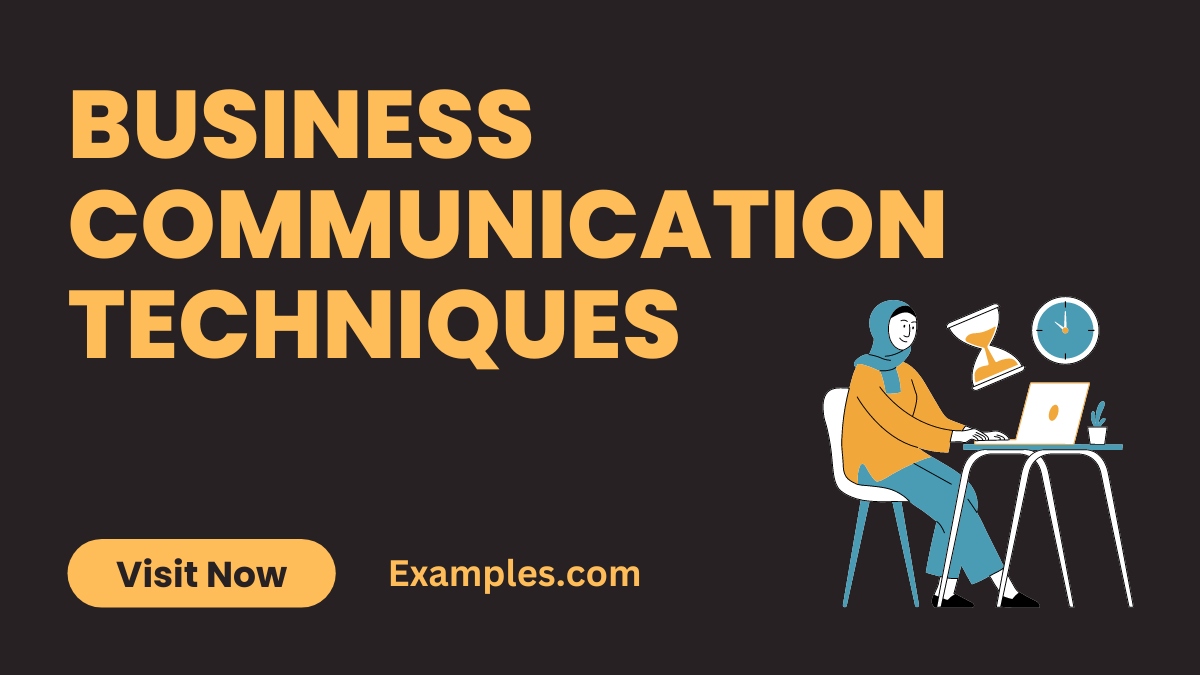Business Communication Techniques
Dive into the world of Business Communication Techniques with this comprehensive guide, enriched with practical Communication Examples. In the bustling arena of professional interactions, mastering these techniques is not just an asset but a necessity. From the boardroom to the break room, effective communication shapes every aspect of business operations. This guide offers insightful examples and strategies, providing a roadmap for anyone eager to enhance their communication skills in the business world. Whether you’re a student, a budding professional, or a seasoned manager, these techniques and examples are pivotal for your communicative success.
What are Business Communication Techniques?

Business Communication Techniques refer to the methods and strategies used to share information and ideas in a business environment effectively. These techniques encompass various forms of communication, such as verbal, non-verbal, written, and digital, each playing a vital role in corporate interactions. They are about more than just speaking or writing; they involve listening, understanding, and engaging with others in a way that is clear, concise, and respectful. Good business communication techniques are essential for efficient operation, teamwork, and problem-solving in any professional setting.
What is the Best Example of Business Communication Techniques?

One of the best examples of Business Communication Techniques in action is during team project meetings. Such meetings require a blend of various communication skills – from clear articulation of ideas and active listening to effective presentation and constructive feedback. A well-conducted team meeting demonstrates how these techniques facilitate collaboration, problem-solving, and consensus-building. Here, participants use both verbal and non-verbal cues to convey their points, listen to and respect others’ opinions, and work together towards a common goal, showcasing effective communication in a crucial business scenario.
15 Business Communication Techniques Examples

In the competitive corporate arena, mastering Business Communication Techniques is key to professional success. This guide showcases 15 examples that illustrate the power and diversity of effective communication in the workplace. From the precision of Written Communication in Business to the subtleties of Non-Verbal Communication, each example demonstrates how different techniques can be applied to enhance clarity, collaboration, and efficiency. Whether it’s through Leadership Communication Strategies or leveraging Modern Communication Tools in Business, these examples highlight essential skills for effective interaction in various business contexts, making them invaluable for professionals at all levels.
- Clear Email Communication: Crafting concise and professional emails for effective information exchange.
- Active Listening in Meetings: Fully engaging and understanding points made by others in meetings.
- Persuasive Sales Pitches: Using compelling language and presentation skills to win over clients.
- Conflict Resolution Techniques: Applying diplomatic skills to resolve workplace disputes.
- Effective Presentation Skills: Delivering engaging and informative presentations.
- Non-Verbal Cues in Negotiations: Utilizing body language to enhance verbal communication.
- Cross-Cultural Sensitivity: Adapting communication styles to suit diverse cultural backgrounds.
- Constructive Feedback Delivery: Providing feedback in a manner that is helpful and encouraging.
- Empathetic Customer Service: Communicating with customers in a way that addresses their needs and builds rapport.
- Team Collaboration Tools: Using digital platforms to facilitate teamwork and project management.
- Effective Networking Strategies: Building professional relationships through skillful and strategic communication at networking events.
- Crisis Communication Management: Handling communication effectively during emergencies or company crises to maintain trust and transparency.
- Internal Newsletters and Memos: Crafting informative and engaging internal communications to keep employees updated and connected.
- Teleconferencing Etiquette: Mastering the nuances of virtual meetings, including speaking clarity and active participation.
- Professional Report Writing: Developing clear, concise, and comprehensive reports for effective business documentation.
Business Communication Techniques for Students
For students preparing to enter the professional world, mastering Business Communication Techniques is crucial. Here are eight techniques especially relevant for students:
- Active Listening: Focus on understanding lectures and group discussions, a skill vital in any business setting.
- Presentation Skills: Practice delivering clear, concise presentations, a common requirement in many professions.
- Writing Skills: Develop the ability to write professionally, from emails to project reports.
- Teamwork Communication: Engage in group projects to hone collaboration and Team Communication Dynamics.
- Networking: Learn to communicate effectively in networking events, a key to career development.
- Using Technology: Familiarize with Business Communication Tools like video conferencing and collaborative software.
- Feedback Reception: Be open to receiving and acting on feedback, a critical part of learning.
- Cross-Cultural Awareness: Understand the basics of Intercultural Business Communication, increasingly important in globalized business environments.
Effective Business Communication Techniques
To enhance the quality and impact of communication in business, consider these eight Effective Business Communication Techniques:
- Clarity and Conciseness: Keep messages clear and to the point to avoid misunderstandings.
- Active Listening: Show engagement and understanding in conversations.
- Empathy: Understand and acknowledge the perspectives of others.
- Feedback: Provide constructive feedback and be receptive to receiving it.
- Non-Verbal Cues: Pay attention to body language and tone, not just words.
- Persuasion Skills: Develop the art of persuading others effectively.
- Cultural Sensitivity: Be aware of and respect cultural differences in communication.
- Adaptability: Flexibly adjust communication style to suit different situations and audiences.
Business Communication Techniques in the Workplace
Effective communication is a linchpin in any workplace. Here are eight key techniques:
- Regular Meetings: Facilitate regular team meetings for updates and feedback.
- Email Etiquette: Maintain professionalism in written communication.
- Conflict Resolution: Address issues promptly and diplomatically.
- Team-Building Activities: Engage in activities that enhance team spirit and communication.
- Transparency: Foster an environment of openness and honesty.
- Mentoring: Encourage senior employees to mentor juniors.
- Listening Sessions: Hold sessions where employees can voice concerns and suggestions.
- Recognition and Appreciation: Communicate appreciation for good work, boosting morale and motivation.
Types of Business Communication Techniques
Business communication is diverse and multifaceted. Here are eight types of techniques:
- Verbal Communication: Face-to-face conversations, telephone calls, video conferencing.
- Written Communication: Emails, reports, memos.
- Visual Communication: Graphs, charts, infographics.
- Non-Verbal Communication: Body language, facial expressions.
- Formal Communication: Official meetings, corporate announcements.
- Informal Communication: Casual conversations, social interactions at work.
- Internal Communication: Between employees and management within the organization.
- External Communication: With clients, suppliers, and other external stakeholders.
What Makes Business Communication Ineffective?
Ineffective business communication often stems from lack of clarity, poor listening skills, and inadequate understanding of the audience’s needs. Overlooking Effective Business Communication techniques leads to misunderstandings.
What is One of the Main Problems in Business Communication?
A primary issue in business communication is the barrier created by misinterpretation and unclear messaging. This highlights the need for refined Business Communication Skills and strategies.
What Should be Avoided in Business Communication?
Avoiding jargon, over-complication, and lack of empathy is crucial in business communication. Effective communicators focus on clarity, conciseness, and understanding the Business Communication Process.
In conclusion, this article on Business Communication Techniques: Examples highlights the critical role of clear, concise, and empathetic communication in the business world. By understanding and applying these techniques, professionals can navigate complex corporate landscapes more effectively, fostering better relationships, enhancing decision-making, and driving organizational success. The examples provided serve as practical guides for refining communication skills in various business contexts.



